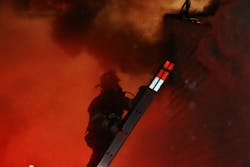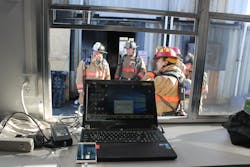Download the full PDF SMARTER: Advancing Health-Related Technology here.
The fire service is experiencing changes on multiple fronts. Gone are the days when the fire chief could justify purchases, policy changes and directives simply based on experience and gut instinct. Mayors and managers expect performance metrics to justify expenses, and firefighters have information and research data immediately available via the smart device they carry in their pocket. In this new age of technology, progressive fire service leaders now demand “data-based decision-making” for not only organizational management decisions but also on-scene emergency response operations. Included with this change is a greater focus on firefighter health and safety.
Embracing technology
Recognizing that technology is all around us raises an important question for the fire service: How do we embrace technology to make firefighters safer and more effective at their jobs?
The SMARTER project has focused specifically on how technology—and especially lightweight technology that is wearable or can easily be carried—can help improve firefighter health and safety. To better understand how technology can be used, we need to understand the following questions:
- What problems or challenges are we hoping to address with technology?
- What technology is available that can be used, adapted or developed for use in the fire service?
- What are the challenges with incorporating any given technology?
Pressing health challenges
A review of firefighter fatality and injury reports is certainly a good place to begin to understand the most pressing health challenges facing the fire service.
Sudden cardiac events (SCEs) have been the leading cause of line-of-duty deaths (LODDs) among firefighters in the United States for many decades. Heat stroke accounts for an unacceptably high number of fatalities, especially in training (see article by Captain King, A12), and heat stress regularly leads to impaired performance on the fireground. Additionally, the devastating toll of cancer in the fire service is increasingly clear, and it is obvious that exposure to fireground smoke and toxins is one important component of the risks that firefighters face. These health challenges are all complex, and there is the potential for technology to help mitigate risks in all cases. But, at present, there is no single technology that addresses all these concerns, or even addresses one concern in a way that can seamlessly be integrated into operations. Thus, one of the important components of this project was to understand how fire departments can begin to incorporate technology.
This project included testing prototypes of technology, adapting existing tools and validating results. But we also considered some of the challenges. Understanding and addressing challenges will undoubtedly be critical to having the fire service embrace technology.
Major concerns of the existing wearable technologies tested with this study include the expense, comfort level and durability. Interpreting and using data in real time can be challenging due to time constraints, expertise, and the urgency to complete the mission. Similarly, agreeing upon algorithms for decision-making based on information provided by the technologies is a substantial challenge. Measuring heart rate is relatively easy, but what constitutes a heart rate that is of concern, or perhaps a better way to look at it is what heart rate for what period of time should be used for decision-making? Likewise, what core body temperature is excessive?
The answer to these questions varies by individuals, and the concern for high physiological strain must be balanced against the need to complete the work that firefighters do. It is undoubtedly less complicated to employ wearable technology during planned training, and it is easier to check on the firefighter if concerns arise. Thus, training may be where wearable technology is first used routinely.
Next generation tools
Yet with all of the challenges, the fact remains that technology is advancing every day, and talented engineers and dedicated fire service personnel will address many of the challenges. Like the development of SCBA many years ago, we are now entering a new era of the next generation of firefighter safety tools.
Yes, challenges exist, and solutions will need to be developed, but the early data suggests a promising future for enhanced firefighter safety.
Read more about the SMARTER project and related studies at skidmore.edu/responder.
More from SMARTER: Advancing Health-Related Technology
About the Author
Dr. Denise Smith
Dr. Denise Smith is a professor at Skidmore College and a research scientist at the Illinois Fire Service Institute (IFSI). She conducts research on the heat stress and cardiovascular strain associated with firefighting, pathoanatomic cause of firefighter fatalities, and strategies to increase performance and decrease cardiovascular events in the fire service.
Craig Haigh
Craig A. Haigh is chief of the Hanover Park, IL, Fire Department and an Instructor with the Illinois Fire Service Institute (IFSI). He is a regular research partner with Skidmore’s First Responder Health & Safety Laboratory. Haigh has a bachelor’s degree in fire and safety engineering, and a master’s degree in executive fire service leadership.

